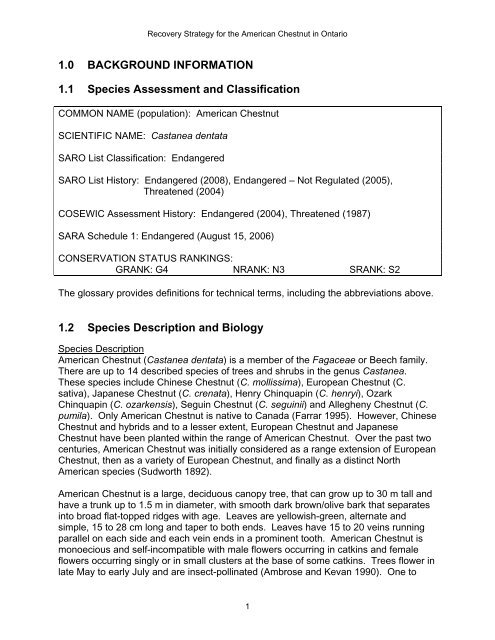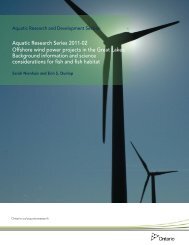(Castanea dentata) in Ontario - Ministry of Natural Resources ...
(Castanea dentata) in Ontario - Ministry of Natural Resources ...
(Castanea dentata) in Ontario - Ministry of Natural Resources ...
You also want an ePaper? Increase the reach of your titles
YUMPU automatically turns print PDFs into web optimized ePapers that Google loves.
Recovery Strategy for the American Chestnut <strong>in</strong> <strong>Ontario</strong><br />
1.0 BACKGROUND INFORMATION<br />
1.1 Species Assessment and Classification<br />
COMMON NAME (population): American Chestnut<br />
SCIENTIFIC NAME: <strong>Castanea</strong> <strong>dentata</strong><br />
SARO List Classification: Endangered<br />
SARO List History: Endangered (2008), Endangered – Not Regulated (2005),<br />
Threatened (2004)<br />
COSEWIC Assessment History: Endangered (2004), Threatened (1987)<br />
SARA Schedule 1: Endangered (August 15, 2006)<br />
CONSERVATION STATUS RANKINGS:<br />
GRANK: G4 NRANK: N3 SRANK: S2<br />
The glossary provides def<strong>in</strong>itions for technical terms, <strong>in</strong>clud<strong>in</strong>g the abbreviations above.<br />
1.2 Species Description and Biology<br />
Species Description<br />
American Chestnut (<strong>Castanea</strong> <strong>dentata</strong>) is a member <strong>of</strong> the Fagaceae or Beech family.<br />
There are up to 14 described species <strong>of</strong> trees and shrubs <strong>in</strong> the genus <strong>Castanea</strong>.<br />
These species <strong>in</strong>clude Ch<strong>in</strong>ese Chestnut (C. mollissima), European Chestnut (C.<br />
sativa), Japanese Chestnut (C. crenata), Henry Ch<strong>in</strong>quap<strong>in</strong> (C. henryi), Ozark<br />
Ch<strong>in</strong>quap<strong>in</strong> (C. ozarkensis), Segu<strong>in</strong> Chestnut (C. segu<strong>in</strong>ii) and Allegheny Chestnut (C.<br />
pumila). Only American Chestnut is native to Canada (Farrar 1995). However, Ch<strong>in</strong>ese<br />
Chestnut and hybrids and to a lesser extent, European Chestnut and Japanese<br />
Chestnut have been planted with<strong>in</strong> the range <strong>of</strong> American Chestnut. Over the past two<br />
centuries, American Chestnut was <strong>in</strong>itially considered as a range extension <strong>of</strong> European<br />
Chestnut, then as a variety <strong>of</strong> European Chestnut, and f<strong>in</strong>ally as a dist<strong>in</strong>ct North<br />
American species (Sudworth 1892).<br />
American Chestnut is a large, deciduous canopy tree, that can grow up to 30 m tall and<br />
have a trunk up to 1.5 m <strong>in</strong> diameter, with smooth dark brown/olive bark that separates<br />
<strong>in</strong>to broad flat-topped ridges with age. Leaves are yellowish-green, alternate and<br />
simple, 15 to 28 cm long and taper to both ends. Leaves have 15 to 20 ve<strong>in</strong>s runn<strong>in</strong>g<br />
parallel on each side and each ve<strong>in</strong> ends <strong>in</strong> a prom<strong>in</strong>ent tooth. American Chestnut is<br />
monoecious and self-<strong>in</strong>compatible with male flowers occurr<strong>in</strong>g <strong>in</strong> catk<strong>in</strong>s and female<br />
flowers occurr<strong>in</strong>g s<strong>in</strong>gly or <strong>in</strong> small clusters at the base <strong>of</strong> some catk<strong>in</strong>s. Trees flower <strong>in</strong><br />
late May to early July and are <strong>in</strong>sect-poll<strong>in</strong>ated (Ambrose and Kevan 1990). One to<br />
1
















